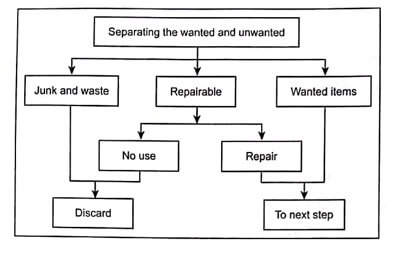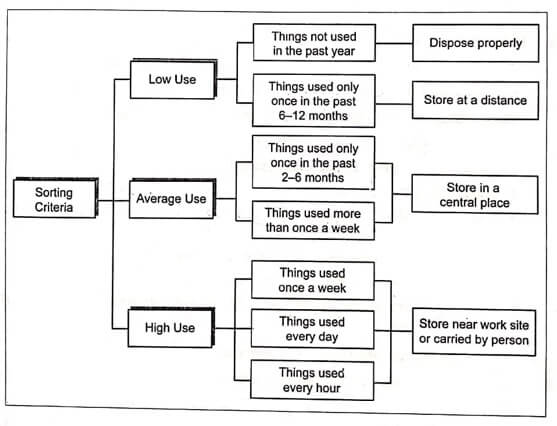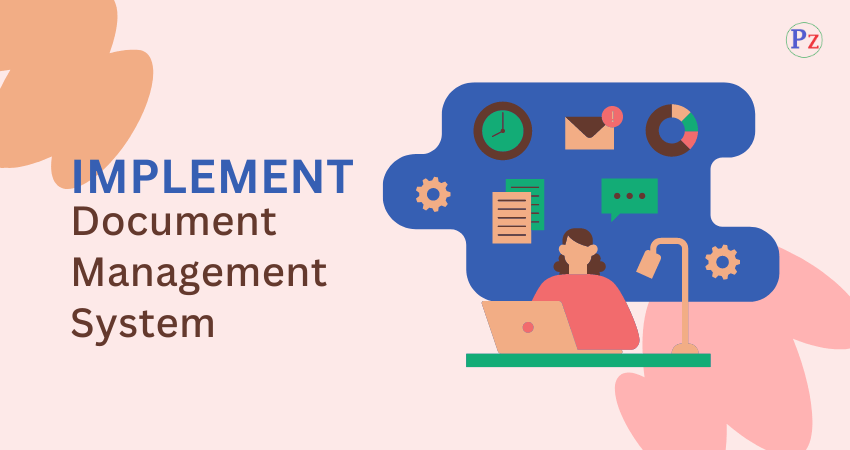5S House Keeping
What is ‘5S ’?
✔ The 5S practice is a house keeping technique used to establish and maintain a productive and quality environment in an organisation.
✔ A well-organized work place results in a safer, more efficient and more productive operation. It boosts the morale of the workers, promoting a sense of pride in their work and ownership of their responsibilities.
✔ 5S was invented in Japan. It stands for five Japanese words that start with the letter ‘S’: SEIRI, SEITON, SEISO, SEIKETSU, and SHITSUKE.
Meaning of ‘5S’ Elements
Table 1. shows the English equivalent and meaning of the 5S elements.
| Japanese Term | English Equivalent | Meaning in Japanese Context |
| 1. SEIRI | Sorting out | Separate out all unnecessary things and eliminate them. |
| 2. SEITON | Systematic arrangement (Straighten) | Arrange the essential things in order, so that they can be easily accessed. |
| 3. SEISO | Spic and span (Scrub, shrine, sweep) | Clean the work place, everything without fail. |
| 4. SEIKETSU | Standardizing | Standardizing the way’ of maintaining cleanliness. |
| 5. SHITSUKE | Self-discipline (sustain) | Practice ‘FIVE S’ daily. Make it a way of life. This also means commitment. |

- To create a neat and clean work place.
- To systemise day-to-day working.
- To improve work efficiency.
- To standardize work practices.
- To improve work discipline.
- To improve the quality of work and products.
- The wanted is hard to find, when required.
- More space is demanded.
- Unwanted items cause misidentification.
- Misidentification causes errors in operation.
- Maintenance cost of the equipments increases.
- At factory floor: Machines to be scrapped; rejected materials; expired goods; broken tools, pallets, bins, trolleys; old notices; scrap heaps outside; etc.
- At office: Broken pens; useless papers; old diaries; broken furniture; etc.
- At home: Broken toys; old clothes; broken suitcases; useless tins; etc.
✔ How to practice SEIRI?
1.Separate the wanted and the unwanted, as shown in the Fig.2 Classify everything by frequency of use. Apply the sorting criteria depicted in Fig.3.
2. Always repair the repairable items immediately. Don’t let them lie around.
3. Throw away unwanted items (or even items used less than in a year). Do not keep them with a vague idea they may be needed. Defectives especially must be identified clearly and removed at fixed intervals.

Fig 2. Separating the wanted and unwanted

Fig 3.Sorting and evaluation criteria
4. Develop a clear and well- understood policy of disposal of broken, unrepairable or unwanted items. DO not let things accumulate for want of policy.
5. Make clear plans for getting rid of waste or dirt or leakages – either by action at the source to prevent its generation (e.g., oil leak from a machine) or by accumulating the waste conveniently (e.g., shavings or clips).
6. If there are items in your shop which you do not need but others may develop a system of putting up a disposal notices with a time limit. If the object is not claimed, discard it.
7. In offices do not file papers which have no reference value. Throw them away. Do not file duplicates and copies. Have a system of specifying the life of each file and destroy unwanted files.
8. Be especially careful to throw away shelf life expired items (if they are allowed to expire in the first place) or expired refills of fire extinguishers, or dead stock. Clear the scrap yard at regular intervals.
2. SEITON: SYSTEMATIZE
✔ SEITON means to arrange everything in proper order so that it can be easily picked up for use. A place for everything and everything in its place.
✔ Consequences of not practising SEITON on the shop floor:
- Things are seldom available when needed.
- Items are ‘lost’ in stores.
- Items-defectives and good ones, or similar looking materials-get mixed up.
- Accidents or near-accidents occur due to cluster.
- Visual control of the shop floor is not possible.
- Some times production is lost because an item required is available but cannot be found.
✔ Some examples of SEITON not in practice:
- At factory floor: Unlabelled tool crib; clustered shelves, lockers; storeson clear location system; things on the floor; etc.
- At office: Unlabelled file cabinet; clustered drawers, shelves, book-cases, tables; Records and documents not arranged well; file heaps and papers all over; etc.
- At home: Cluster; no orderly arrangement-in drawing room or kitchen or anywhere.
- All materials and parts must have clear labelled locations, rack numbers or bins. Hazardous items must be separated.
- Location of parts must be centrally known on display board or on computer. Nearer the location, aisles, bays must be numbered, coded or labelled.
- All bays and passages must be entirely clear.
- Receipt area, inspection area must be clearly marked out.
- Frequently used parts under inspection, OK parts, rejects, as well as materials under sorting or salvage.
- Re-order levels should be visible to ensure that prompt orders are placed.
✔ How to practice SEITON on shop floor?
- Dies, moulds, jigs, fixtures must be placed back at their locations – after ensuring that they are in good condition and after necessary oiling, etc. They must be labelled clearly, with specified dates for next regrind or inspection.
- Small tools, cutting tools, bits, etc., must be placed in shelves, drawers, cupboards neatly, and well labelled.
- Consumables must be stored in appropriately marked areas and labelled. Expiry dates must be clearly visible.
- Good products, defectives, rework items, scrap must all be identified separately so that there is not chance of mix-up.
- Work-in-process must be kept in designated locations with labels both within a workshop and between two processes.
✔ How to practice SEITON in the office?
- Everyone must design a filing system appropriate for his purpose. Every file must have a designated (file) life.
- Old files kept for records (not for current use) must be separated from current file.
- Temporary papers (fixing a visit schedule or ticketing) should not be filed at all.
- Documents and records which need protect storage must be identified and kept in appropriate cabinets. These files should have displayed indents of each paper and responsibility.
- Aisles must be clear. Nothing must lie on the floor.
3. SEISO: SHINE
✔ SEISO means to clean the workplace thoroughly so that there is no dust/dirt/scrap anywhere.
- Mist machines are affected by dust and dirt. Their performance may go down, they may wear out faster. The costs can be huge.
- Dust and dirt on products, materials, packing boxes will almost certainly affect either their performance quality or atleast their aesthetic quality.
- A dusty and dirty place is unpleasant to work in.
- By not practising seiri, seiton, and seiso, management is in effect communicating clearly to the employees of the following:
“It is not important to do things well here. You can do it anyway. Quality is not important. Care of machines, parts, materials tooling is not a priority. In fact you are not important.”
✔ Some examples of poor SEISO:
- At factory floor: Dirty machines; dust on products, parts, raw materials; dirty jigs, fixtures, moulds; dusty walls, roofs, littered floor; etc.
- At office: Dusty table and furniture; dirty office equipment-typewriter, photo copies, computers; littered floor; etc.
- At home: Dirty furniture; dusty window rills, windows, doors; dirty bookshelves, cupboards; dusty floor, fans; etc.
✔ How to practice SEISO?
- Sweeping inside the lines is the responsibility of people working in that line. This includes cleaning of machines, tooling, bins, pallets, etc.
- Packing bags, rejects, spilled powders, paper, etc. must not be allowed to first drop on the floor and then swept out of the lines and cleared later by sweeping staff.
- Oil and other liquid spills should not take place but if they do they must be cleaned and the stains removed.
- Inaccessible parts like roofs, high walls must be swept out.
- Outside the built-up area, sweeping and washing must be kept up regularly.
- Toilets should be kept clean and well supplied.
4. SEIKETSU: STANDARDISE
✔ SEIKETSU means maintaining a high standard of workplace organisation and house keeping at all times.
✔ It always aims at maintaining the standard level of cleanliness, hygiene and visual control.
✔ Consequences of not practising SEIKETSU:
- Dual standards yield multiple results.
- Multiple results lead to conflicts and confusions.
- Rework increases.
- Rework increases the basic cost of the finished product without any value addition.
✔ How to practice SEIKETSU?
- Colour coding
- Fool-proofing (poka-yoke)
- Responsibility labels
- Wire management
- Inspection marks
- Prevention of dusts, dirt, noise and vibration
- “I-can-do-it-blindfolded”
- One-point-lessons
- Visual control signs
✔ While doing SEIKETSU keep in mind:
- The standards should be arrived unanimously.
- Always keep the standards flexible to changes and improvements.
- Standards should be known to all and displayed.
5. SHITSUKE: SELF-DISCIPLINE
✔ SHITSUKE denotes self-discipline, especially with regard to safety rules and punctuality.




